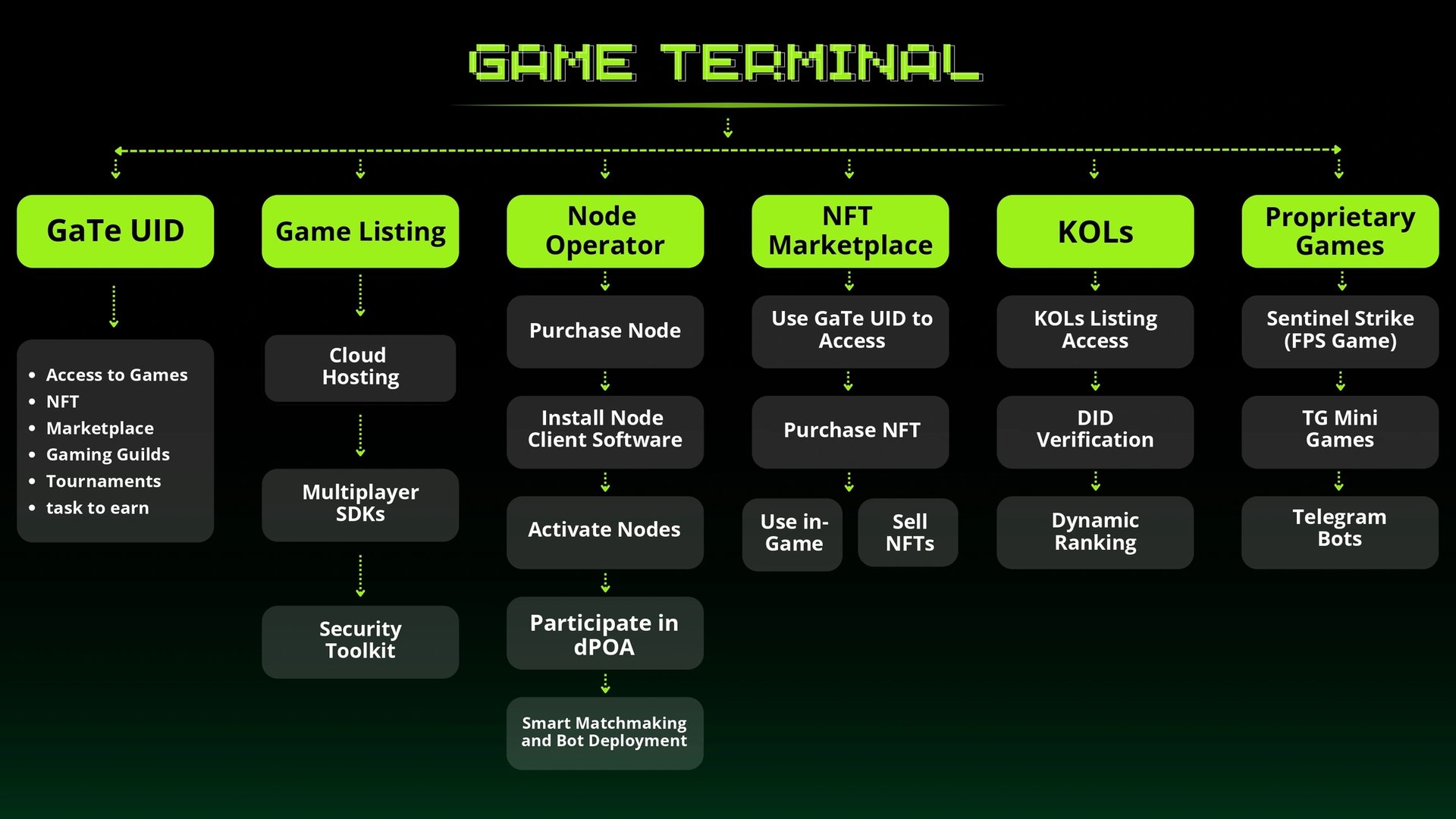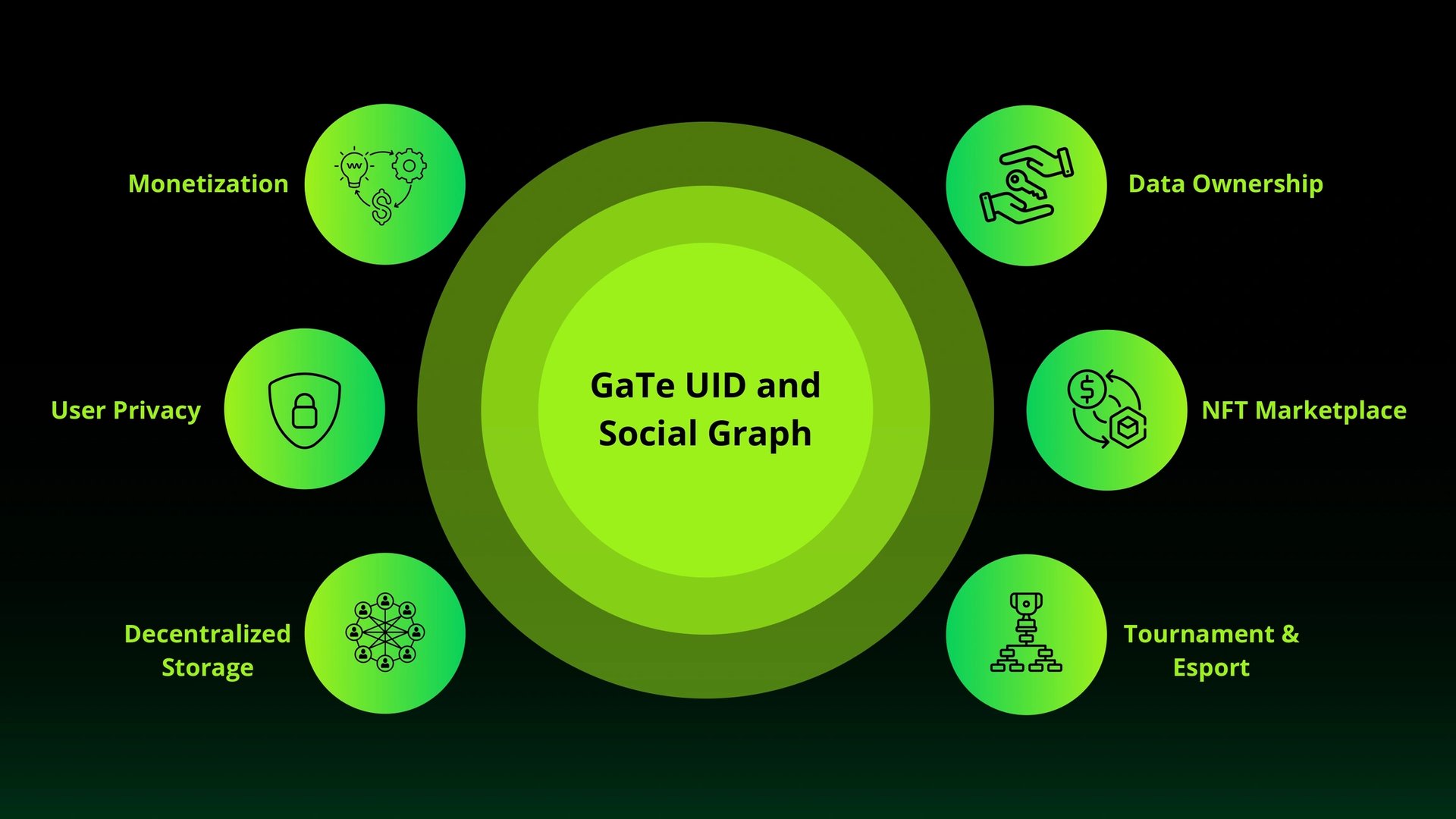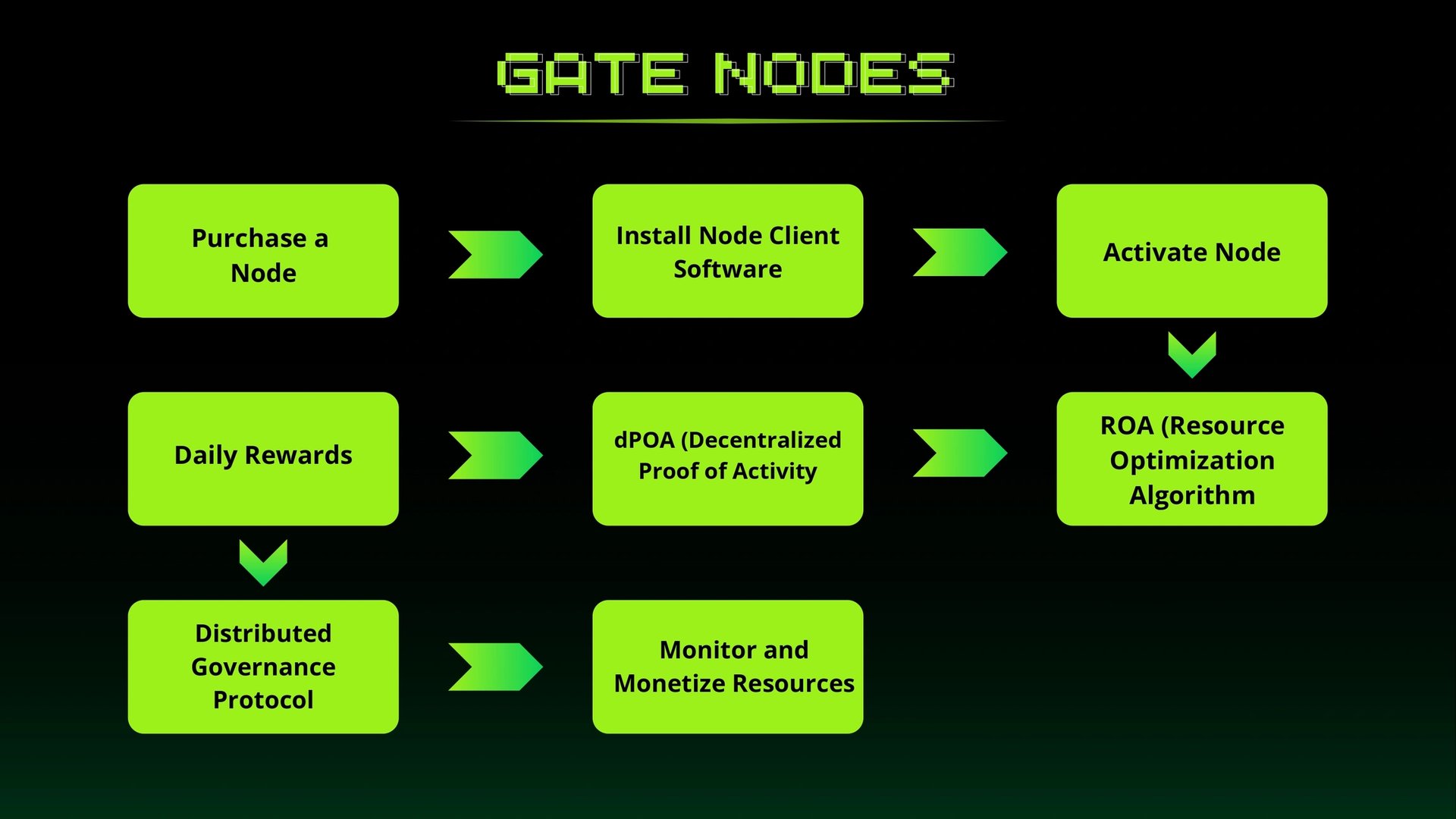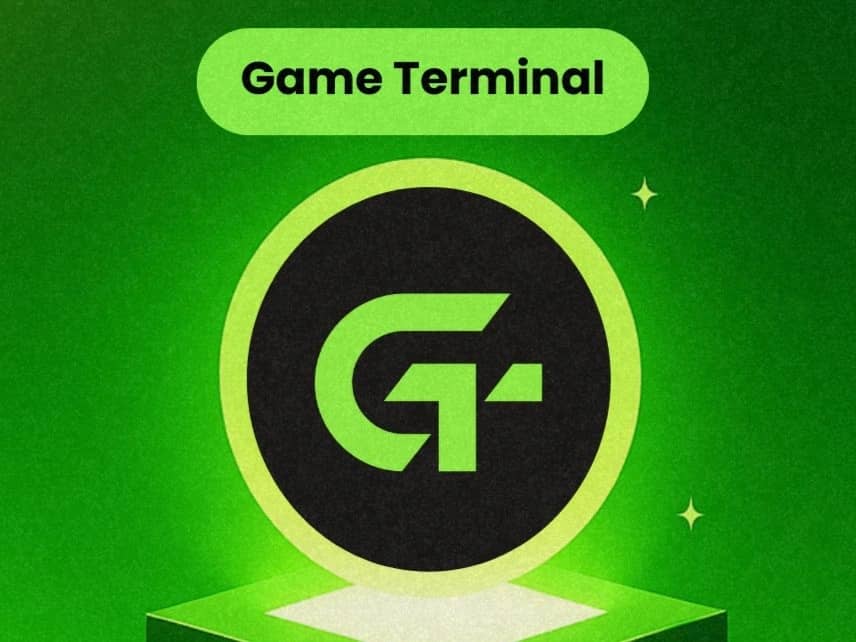订阅 wiki
Share wiki
Bookmark
Game Terminal
Game Terminal
Game Terminal 是一个 Web3 游戏平台,它作为去中心化游戏的一个综合中心,集成了 区块链 技术、人工智能和去中心化社交系统,为玩家和开发者创建一个统一的生态系统。[6]

概述
Game Terminal 将自身定位在 Web3 技术和游戏的交叉点,旨在解决当前游戏领域中的碎片化挑战。该平台被设计为“Web3 的 Epic Games”,在去中心化游戏生态系统中提供一个中心化的枢纽。通过利用 区块链 基础设施、人工智能和去中心化社交图谱,Game Terminal 致力于创建一个环境,让游戏开发者可以扩展他们的项目,而玩家可以参与到沉浸式的游戏体验中。[6] [9]
主要特性和技术
平台架构
Game Terminal 的技术基础设施建立在几个相互连接的层面上:
- 内聚实体层:将游戏资产、玩家、NFT 和 智能合约 表示为数字实体,促进游戏和用户之间的无缝互动,同时确保透明度和所有权 [1]
- 数据存储层:利用 IPFS 和 区块链 等去中心化存储解决方案,安全、不可变地存储玩家资料、游戏元数据和交易记录 [2]
- 计算层:通过可扩展的基础设施为游戏逻辑、智能合约 执行和复杂计算提供动力,支持实时游戏和 区块链 互动 [3]
- 数据流层:管理各层之间的无缝数据传输,通过低延迟、高效的数据处理实现游戏、用户和服务之间的平滑集成 [4]
- 验证层:通过共识机制和智能合约验证,确保数据的准确性、完整性和安全性 [5]
生态系统

GaTe UID

GaTe UID 是一个基于 区块链 的数字身份,分配给 Game Terminal 生态系统中的每个玩家。它以 非同质化代币 (NFT) 的形式发布,记录并反映玩家在所有集成游戏中的活动和成就。这包括游戏历史、锦标赛参与、NFT 交易和奖励累积,形成一个全面的个人资料和动态社交图谱。
通过利用去中心化账本技术,所有相关数据都存储在分布式 节点 上,避免了与中心化数据系统相关的风险。这种结构允许玩家保留对其信息的完全控制权,符合数据主权原则。[11]
游戏列表平台
Game Terminal 游戏列表平台充当各种类型和格式的 Web3 游戏的去中心化入口点。它旨在通过统一的系统连接开发者和玩家,从而支持游戏的发现、集成和分发。
作为 Game Terminal 生态系统的核心基础设施,该平台使开发者能够向全球用户群展示他们的项目。它支持各种游戏——包括休闲、独立、竞技和 AAA 级游戏——并提供直接访问和下载的工具。列表过程的结构旨在适应不同的项目类型,同时旨在简化去中心化环境中的曝光。[8]
节点协议

节点 协议是支持 Game Terminal 平台去中心化架构的基础设施。通过使用户能够在个人设备上运行 GaTe 节点,该网络将计算任务和内容交付分配到点对点系统上,从而减少延迟并减少对中心化服务器的依赖。
GaTe 节点 用作验证器和内容分发器,促进安全的数据交换并增强系统弹性。参与者通过获取许可证并连接到网络来激活 节点,他们的设备在其中贡献带宽、存储和正常运行时间。
该网络采用分布式活动证明 (dPoA) 共识模型,该模型根据 节点 的运营绩效和参与度对其进行评估和奖励。这种机制通过激励持续参与和维护网络完整性来支持去中心化生态系统。[10]
NFT 市场
Game Terminal (GaTe) NFT 市场充当一个去中心化平台,用于交换与 Game Terminal 生态系统上可用的游戏相关的数字资产。它促进各种 非同质化代币 (NFT) 的交易,包括游戏内物品、头像、收藏品和基于比特币的资产,例如 Ordinals 和 Runes。
特点
- 跨游戏交易:该市场允许用户在统一的界面中交换来自多个集成游戏的 NFT,旨在增强资产互操作性和市场流动性。
- 基于比特币的资产支持:列表包括 比特币 协议原生的数字资产,例如 Ordinals 和 Runes,从而将市场的范围扩展到 以太坊 基础生态系统之外。
- 去中心化框架:交易由 智能合约 管理,通过无需信任的机制消除中介并降低交易对手风险。
- 界面可访问性:该平台专为广泛的可用性而设计,提供了一个对经验丰富的加密货币用户和新手都可访问的界面。
KOLs 市场
Game Terminal 上的 KOLs 市场是一个去中心化平台,旨在将 Web3 游戏项目与 YouTube、X(以前的 Twitter)和 Twitch 等社交媒体渠道上的影响者和内容创作者联系起来。它建立在 区块链 基础设施之上,结合了去中心化标识符 (DID) 和 智能合约,以促进游戏项目和关键意见领袖 (KOL) 之间透明、安全和自动化的协作。
该平台维护一个经过验证的 KOL 的链上目录,每个个人资料都链接到一个 DID,用于无需信任的身份验证。一个去中心化的声誉系统跟踪参与度指标和历史表现,这些指标被转换为用于排名和可见性的忠诚度积分。一个动态算法根据社交媒体活动和内容表现实时更新这些排名。[12]
专有游戏
Sentinel Strike 是 Game Terminal 内部开发的第一人称和第三人称射击游戏 (FPS/TPS),它在竞争性游戏框架内结合了 区块链 元素。受 Counter-Strike 和 Call of Duty 等传统射击游戏的影响,该游戏包括玩家对环境 (PvE) 和玩家对玩家 (PvP) 模式,以及大规模多人竞技场。
Sentinel Strike 具有自适应 AI 系统,可根据玩家互动修改敌人行为和游戏动态。其视觉设计支持高分辨率图形和电影效果,并且该游戏包括超过 200 平方公里的广阔开放世界地图。[13]
技术基础设施
- 智能合约:核心操作(例如 铸造、交易和拍卖)通过 以太坊 和 比特币 兼容的 智能合约 进行。
- 跨链互操作性:利用桥接协议来实现 NFT 在不同 区块链 之间的转移,从而扩大网络兼容性和资产覆盖范围。
- 去中心化存储:NFT 的元数据托管在 IPFS 等分布式存储系统上,以保持数据完整性并抵制审查。
- 钱包集成:支持各种钱包,包括 MetaMask、WalletConnect 和 比特币 兼容选项,为用户提供跨区块链环境的灵活性。[7]
代币经济学
Game Terminal 代币 ($GTT)
Game Terminal 的原生实用代币 GTT 于 2025 年 3 月 24 日推出,总供应量为 10 亿个代币。该项目将 27% 的供应量分配用于公开发售,初始流通供应量为 2630 万个代币,占总量的 2.63%。公开发售价格定为每个代币 0.012 美元,导致初始市值(不包括流动性)为 315,600 美元。GTT 旨在用作 Game Terminal 生态系统中的交易和治理资产。[14]

发现错误了吗?
